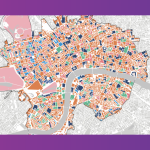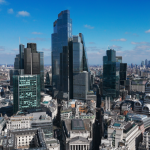Headline findings for a selection of our indicators (all provided further below in the report) are as follows:
In 2021, London recorded modest recovery in its economic output level, but it is still operating below pre-Pandemic (2019) levels
The cities in our survey share a basic economic pattern: they all record a fall in output over the first two quarters of 2020, recoveries in the second half of that year followed by generally lower levels of growth (and even some shrinkage) in 2021. However, London’s recovery appears to have stalled in the second half of 2021 with Q3 growth of just 1.5% (quarter on quarter) compared to 4.6% in Q2.
There are mixed signals coming from London’s labour market:
- London’s unemployment rate of 5.6% (Q3, 2021) compares favourably particularly against New York and Berlin (both have unemployment rates of nearly 10%) but less so with Hong Kong (4.7%). London’s unemployment rate remains the highest for any region in the United Kingdom.
- Employment levels – the number of people in work – in London have outperformed other world cities – the capital sits at the top of the table compared to pre-Covid figures – despite the impact of the pandemic.
- Notwithstanding this, London suffered the biggest reduction in posted job vacancies during 2020 but since then has seen vacancy rates increase significantly. When compared to London, job postings are higher in New York and Berlin but lower in Paris and Hong Kong.
In all cities, office vacancy rates have risen sharply during the pandemic period but there are signs of recovery except for New York.
- New York (Manhattan) has seen one of the largest increases in office vacancy rates which is now very high at 19%.
- Paris and Berlin continue to outperform with lower vacancy rates.
- London and Paris are the only cities to have recorded a fall in office vacancy rates this year.
Prime office rent figures for Q3, 2021 show London’s West End values rebounding but the City is still in negative territory
- Rents in the West End have shown strong performance – up 18% year on year (Q3, 2021 vs Q3 2020) but City rents showed some weakening (down 1.4%) over the same period.
- New York (Midtown), Hong Kong and Paris have witnessed continuing softening in rents with only Berlin in positive territory alongside London’s West End.
High Street consumer activity is still below pre-Covid-19 levels in London, Paris and New York, despite the lifting of many restrictions
- Retail visits as measured by Google in London, Paris, Berlin and New York are between twenty and thirty percent below pre-pandemic levels. Hong Kong has seen the strongest recovery.
- Restaurant bookings for the end of November 2021 show London is still 15% below 2019 benchmark levels with New York some 35% off the pace.
With the notable exception of Hong Kong, office working activity remains significantly lower than pre-pandemic levels in London, Paris, Berlin and New York. This is reflected in levels of public transport usage. The potential impact of the Omicron variant is not yet reflected in these numbers
- In 2021, Google data indicated a modest return to office-based employment across all cities but this has stalled in Berlin and London.
- London is seeing a slower return to the office than all other cities apart from New York (London is -29% of its pre-Covid benchmark; New York is -33%).
- Prolonged reduced levels of public transport ridership present a material threat to public transport in London. This is because TfL is historically far more reliant on fare revenue than many other cities’ public transport systems.
- At the time of writing, TfL was yet to conclude a lasting financial settlement with central government. This threatens the long term viability of the public transport system in London – whilst competitor cities continue to enjoy substantial levels of financial support from their central governments, associated with the impact of the Covid pandemic.
Whilst public transport use remains depressed, road congestion has exceeded pre-pandemic levels in London, New York and Paris.
- London is more congested than before the pandemic – in November 2021, congestion was 18% higher compared to the pre-Covid benchmark.
- Only Paris is recording a higher level of congestion than London amongst our survey cities.
Air travel demand and visitors were gradually returning to many cities but London’s position remains comparatively weak. Hong Kong numbers remain very depressed. This is before the impact of restrictions associated with the Omicron variant.
- Airport passenger numbers have seen some recovery since spring 2021, with New York, Paris and Berlin back to over 50% of pre-Covid levels. London is only at 34%.
- Data on Airbnb occupancy shows that despite the reopening of the UK to more international visitors in autumn of this year, occupancy in Paris, Berlin and New York is higher (all close to 40%) compared to London (31%). Hong Kong is struggling with only 8% occupancy.


